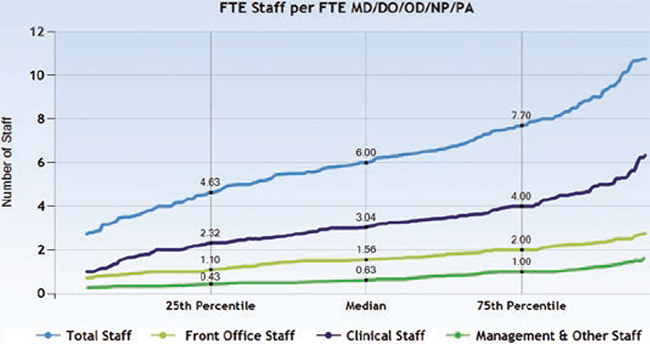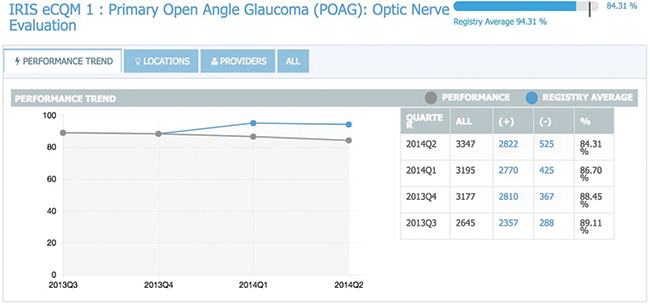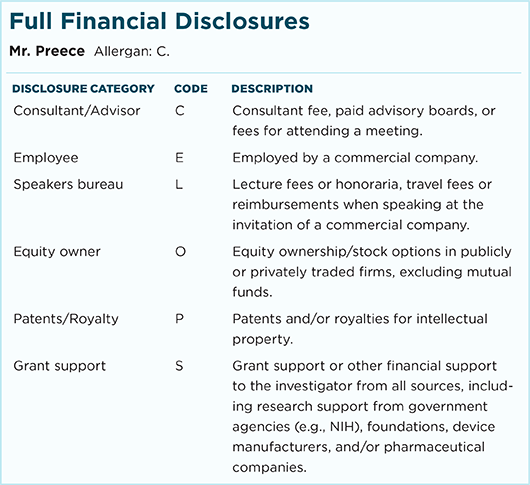Download PDF
I could sense the frustration in the doctor’s voice: “You’ve got to help us figure out what’s wrong with our front-desk staff. My partners and I spend too much time standing around in the exam lane area waiting for patients to be processed at the front desk. I don’t know why the receptionists can’t get them registered quicker.” We spoke a little longer, as I asked him questions and he provided the best answers he could. Before I left, I asked his office manager to send me 2 specific data points.
Benchmarking in action. A few days later we spoke again. I told him that the median number of patient encounters per full-time equivalent* receptionist was 2,800 per year. “Would you care to guess how many encounters your 2 receptionists are handling per year?” He didn’t know, but because I had posed the question, he surmised that it was more than 2,800. “You’re right,” I confirmed, “Your staff handle about 3,600 encounters per year per full-time person, which is well above the 75th percentile. There may be some ways to streamline what they are doing so patients are processed faster, but the bottom line is this—your practice needs more help at your front desk!”
Having a benchmark for the number of encounters the front desk staff should be expected to handle per year allowed us to quickly identify one cause of the problem this doctor’s practice was experiencing.
Know the Vital Signs of Practice Management
Benchmarks for ophthalmology practices are analogous to the vital signs that physicians measure in their patients before prescribing treatments. Suppose, for example, a patient presents with a blood pressure of 180/110. That reading would have limited value without a benchmark to compare it against; but an internist, aware that the benchmark is 120/80, would be concerned about the elevated pressure and would seek to identify and treat the underlying cause. In the same way, financial and patient flow benchmarks help you detect areas of your business that are not within normal limits.
AcadeMetrics benchmarks were developed specifically for ophthalmology practices. The Academy and AAOE provide a benchmarking tool—called AcadeMetrics—that enables you to compare your practice’s financial and patient flow results with other, similar practices.
AcadeMetrics has 72 benchmarks. These include the following:
- Overhead ratio—judge how efficient your practice is in converting collections into cash for the owners.
- Physician productivity ratios by subspecialty—gauge whether your providers are seeing a typical number of patients and generating normal revenues.
- Employee productivity ratios—understand whether you have enough staff in various areas of the practice.
- Accounts receivable ratios—monitor your billing staff’s effectiveness in collecting money owed to you.
- Optical ratios—analyze the profitability of your optical operations.
Many of the 72 benchmarks are unique to the AcadeMetrics survey and are not published elsewhere. Only data that are required to generate the benchmarks are collected, and practices that do not have an optical shop or a physician in a particular subspecialty can skip those fields.
 |
|
GET SOME PERSPECTIVE. Compare your numbers on up to 72 indicators—such as staffing ratios (above)—with benchmarks based on similar practices.
|
AcadeMetrics—How to Start Benchmarking Your Practice
By participating in the AcadeMetrics survey, you’ll be able to access detailed comparison reports that will help you to identify the specific strengths and weaknesses of your practice.
How it works. Each spring, ophthalmology practices start entering their data from the previous fiscal year. The resulting benchmarks and comparative reports will be available only to practices that complete at least 50% of the AcadeMetrics survey; the data won’t be available for purchase by nonparticipants.
When to sign up. You will be able to sign up for the AcadeMetrics survey after the March 28 benchmarking webinar. Here's how:
Your data are confidential. Your data will not be seen by other AcadeMetrics participants. Identifiers specific to your practice will be stripped from the final dataset, and the reporting tools will only display datasets that include a minimum of 10 items. (This minimum applies to both complete aggregated datasets and to any filtered dataset.)
Start using the benchmarks. You will be able to start comparing your performance against certain benchmarks as soon as you submit your data; other benchmarks will become available once enough participants complete the survey.
What does it cost? AcadeMetrics is free for Academy and AAOE members.
 |
YOU ALSO CAN USE THE IRIS REGISTRY FOR CLINICAL BENCHMARKING. By benchmarking financial and patient flow performance, AcadeMetrics complements the IRIS Registry, which benchmarks clinical performance. If you have an electronic health record (EHR) system, you can integrate it with the IRIS Registry, which periodically extracts clinical data from your EHRs. For more information on the IRIS Registry, including a list of EHR systems that have successfully been integrated with it, visit aao.org/iris-registry.
|
Use AcadeMetrics Data to Identify Problems Early
The importance of knowing your key benchmarking figures was illustrated in a call that I received from a doctor several years ago. She phoned because the owners felt that they were making less-than-average income for ophthalmologists and thought they might need to cut some overhead expenses.
Benchmarking surfaces hidden problems. My analysis, using her practice’s data and the AcadeMetrics benchmarking data, confirmed that their overhead ratio was too high, but it also showed that the main cause was that the physicians were generating collections well below the 25th percentile for their subspecialties.
An unidentified problem is an unsolved problem. Because no comparative benchmarking had been done in the practice, none of the physicians realized that they were bringing in much less revenue than their peers. And since they were unaware of the primary cause of their reduced income, they hadn’t taken appropriate steps to address it. Consequently, over the previous years, their below-average revenue had prevented them from investing in the equipment needed to keep up to date, from ensuring their staff pay rates were competitive with the market, and from enjoying a more secure lifestyle.
Catch pernicious problems early. The situation at her practice reminded me of a quote that I had once read about high blood pressure: “The condition itself usually has no symptoms. You can have it for years without knowing it. During this time, though, high blood pressure can damage the heart, blood vessels, kidneys, and other parts of your body. Knowing your blood pressure numbers is important, even when you’re feeling fine.”
Likewise, knowing your AcadeMetrics benchmarking numbers can protect you from sustaining acute and immediate damage to your practice. Longer term, this knowledge can help prevent the silent impairment that could show up in your practice years later in unhealthy and sometimes irreversible ways.
For more information, visit aao.org/academetrics.
Don't miss the benchmarking webinar. On March 28, Mr. Preece will present “Benchmarking: Use KPIs to Improve Practice Profit & Efficiencies.” Register today.
___________________________
* To calculate how many full-time equivalent staff members you have, add up the total number of staff hours paid during the year and divide that by 2,080.
___________________________
Mr. Preece is a principal and executive consultant with BSM Consulting and assists Academy staff with the AcadeMetrics benchmarking survey. Relevant financial disclosures: None.
For full disclosures and the disclosure key, see below.
